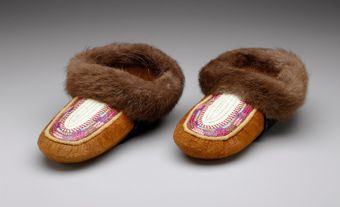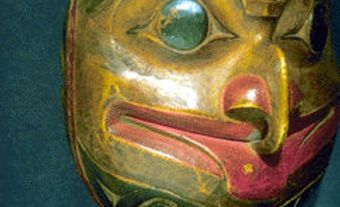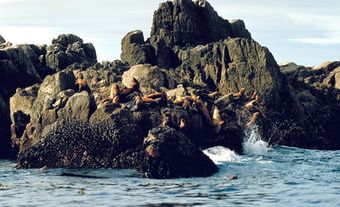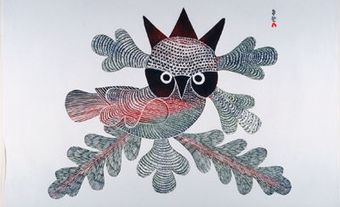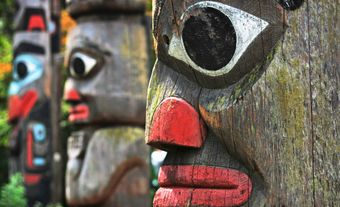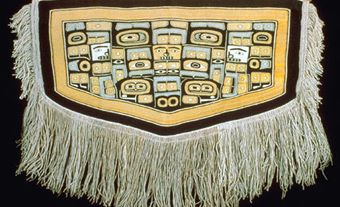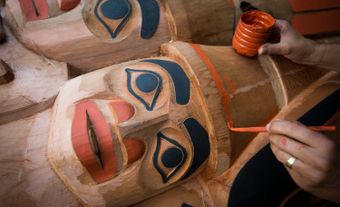Freda Diesing, Haida artist (born 2 June 1925 in Prince Rupert, BC; died there 3 December 2002). Diesing was best known for her contributions to reviving traditional Haida art forms, including wood carving, mask carving and totem carving. She was one of the few women carvers who mastered the medium, and was partly responsible for bringing the style to an international audience. Diesing worked to ensure the style and tradition of Haida art was passed on to new generations. (See also Northwest Coast Indigenous Art and Contemporary Indigenous Art in Canada.)

Early Life and Ancestry
Freda Diesing was born Marie Alfreda Johnson. She was also known as Kant-wuss and Weguedaas. Her Haida name, Skilquewat, can be translated as “On (or crossing) the Trail of Property Woman.” After her father died when she was young, Freda used her stepfather’s surname, Lambly, even though her legal name remained Johnson. Her surname changed again when she married Arthur (Art) Diesing in 1956.
Freda and her parents, Flossie and Franz Johnson, were members of the Eagle clan, Sadjugalth Lanas Gitans, of the Haida Nation in British Columbia. She came from a distinguished Haida family on her mother’s side. Her maternal great-grandfather from Masset, Haida Gwaii, was a Haida carver. However, she only became acquainted with his work displayed in museums, after she had decided to become a carver herself. She credits her maternal grandmother, who was a root basket weaver and sister to jewellers and master carvers, with teaching her about Haida art and heritage.
Artistic Career
Freda Diesing took painting classes at the Vancouver School of Art in 1955-6, beginning her artistic career. She saw the exhibit, “People of the Potlatch”, at the Vancouver Art Gallery in 1956 and began to take an interest in the artistic traditions of her Haida ancestors. She began carving at the age of 42, learning at the Gitanmaax School of Northwest Coast Indian Art at ‘Ksan Village, under the direction of Robert Davidson, Tony Hunt, Bill Holm, Duane Pasco and Nathan Jackson.
In the 1960s, Diesing was one of a small group of artists who were responsible for the rediscovery and revival of Northwest Coast art. Traditional Haida culture, including visual arts and carving, had nearly died out by 1910. This was a consequence of the diseases that had ravaged First Nations communities since the era of first contact with Europeans. Additionally, this demise was brought on by the government’s ban on the potlatch and the destruction of Indigenous culture caused by the forced removal of Indigenous children to attend residential schools.
Diesing was known for challenging the conventions of Haida art. Namely, she was an accomplished carver and printmaker in a domain that was traditionally male dominated. In the 1970s, Diesing took an interest in silkscreen printing, and adapted traditional Haida styles to the medium. In the 1980s, her work was included in a special exhibit by the Royal British Columbia Museum called “Legacy — Tradition and Innovation in Northwest Coast Indian Art,” which brought the style renewed notoriety and international acclaim.
Her life’s work included traditional styles in myriad mediums. Though she was best known for carving masks, particularly of women or feminine figures, she also carved and raised numerous totem poles. Diesing’s totems stand in Prince Rupert and in Terrace, British Columbia, the two communities she lived most of her life in. She also designed ceremonial button blankets and carved wall panels for the Prince Rupert General Hospital. She was an artist-in-residence for a period of time in the Dominican Republic and participated in international sculpture symposia in Finland.
Throughout her career, Diesing exhibited her work across Canada and internationally, with frequent exhibits at the Vancouver Art Gallery, the Inuit Art Gallery of Vancouver and the Thunder Bay Art Gallery, as well as numerous exhibits in government office buildings throughout the National Capital Region. Collections of her work can also be found at the Canadian Museum of History in Gatineau, Quebec, the Royal Ontario Museum in Toronto, the City of Prince Rupert and the then named federal department of Crown-Indigenous Relations and Northern Affairs Canada. In 2019-20, Diesing’s work was included in an exhibit at the Frist Art Museum in Nashville, Tennessee. It was described as the first major museum exhibition devoted to Indigenous women artists from the USA and Canada.
Did You Know?
In 2006, Coast Mountain College (formerly Northwest Community College) inaugurated the Freda Diesing School of Northwest Coast Art. Diesing’s student Dempsey Bob was one of the school’s first instructors.
Teaching and Other Work
Freda Diesing eventually became an instructor at the ‘Ksan Indian Art School. Each year, she also taught a seminar in carving in Ketchikan, Alaska. Diesing was an important teacher and mentor; most of her students went on to form the core of a new generation of Indigenous artists working in Canada. She was known as a mentor to Don Yeomans and Dempsey Bob. After Freda Diesing passed away in 2002, Yeomans and Bob delivered her eulogy.
In addition to her career as an artist and teacher, Diesing was also a member of the Council of the Haida Nation of British Columbia as well as a singer with the group the Sweet Adelines.
Awards and Honours
- Honorary Diploma, Northwest Community College (now Coast Mountain College) (2000).
- National Aboriginal Achievement Award (now Indspire) (2002).
- Honorary Doctorate, University of Northern British Columbia (2002).

 Share on Facebook
Share on Facebook Share on X
Share on X Share by Email
Share by Email Share on Google Classroom
Share on Google Classroom

